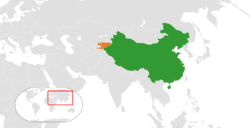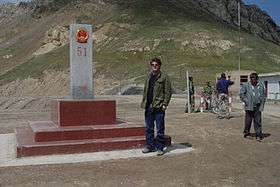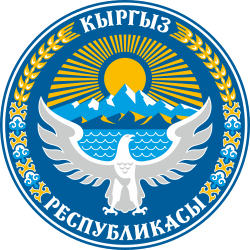China–Kyrgyzstan relations
As of 1996, China-Kyrgyzstan relations were an area of substantial uncertainty for the government in Bishkek.[1] The free-trade zone in Naryn attracted large numbers of Chinese businesspeople, who came to dominate most of the republic's import and export of small goods.[1] Most of this trade is in barter conducted by ethnic Kyrgyz or Kazakhs who are Chinese citizens.[1] The Kyrgyzstani government had expressed alarm over the numbers of Chinese who were moving into Naryn and other parts of Kyrgyzstan, but no preventive measures had been taken as of 1996.[1]
 | |
China |
Kyrgyzstan |
|---|---|
Migration

Relations between the two nations are hindered by the fact, that China does not want the independence of Kyrgyzstan, a Turkic state, to encourage Turkic inhabitants of China's Xinjiang province, to pursue their own independence.[1] There is some anti-Uygur sentiment in Kyrgyzstan. Daniar Usenov, who became the Prime Minister of Kyrgyzstan in 2009, received accolades from multiple Kyrgyzstan newspapers by articulating the fear in 1999 that Kyrgyzstan would become "Uygurstan" through an alleged Chinese plot of miscegenation.[2] Kyrgyzstan refused to permit the formation of an Uygur party.[1]
Trade

In the 1990s, trade with China grew enormously.[1] Particularly important is the re-export of Chinese consumer goods to the neighboring Uzbekistan (mostly via Karasuu Bazar at Kara-Suu, Osh Province) and to Kazakhstan and Russia (mostly via Dordoy Bazaar in Bishkek).[3] Due to its linguistic and cultural affinity with the Chinese (particularly, Hui) people, Kyrgyzstan's small Dungan community plays a significant role in the trade. In some political quarters, the prospect of Chinese domination stimulated nostalgia for the days of Moscow's control.[1]
As of 2019, China is one of the main trade and economic partners of Kyrgyzstan. China is also the main bilateral creditor of Kyrgyzstan. Their economic relationship is highly asymmetrical as "[w]hile for China the bilateral projects in Kyrgyzstan are small, they are significant for Kyrgyzstan".[4]
Territorial claims
China has claimed large tracts of Kyrgyzstan territory, encompassing almost the whole of the country. As per Chinese historians, in the second half of the 19th century, China's Qing dynasty was forced to enter into a number of unequal treaties where Kyrgyz lands, particularly the North Kyrgyz lands were ceded to the Russian Empire in 1863.[5]
In May 2020, Chinese websites Tuotiao.com claimed that Kyrgyzstan and Kazakhstan were part of China and that "under the Khan dynasty, 510,000 square kilometre of Kyrgystan, which means the entire country was part of Chinese lands but the Russian empire took over the territory."[6][7]
Cooperation
Recent events in Kyrgyzstan have been of great concern to China, not only because of the issue over the Uygurs, but also due to problems with narcotic trafficking.[8] During the 2005 Tulip Revolution China considered developments in Kyrgyzstan so important that they raised the possibility of deploying combat forces.[8] In 2010 a spokesperson for the Ministry of Foreign Affairs of the People's Republic of China stated that "we are deeply concerned over the developments of ISI Clandestine Operations in Kyrgyzstan and hope to see early restoration of order and stability in the country and that relevant issues can be settled through the legal means."[8]
Kyrgyzstan and China have concluded joint military exercises several times. Kyrgyzstan has participated in the Shanghai Cooperation Organization's series of joint military exercises (titled "Peace Mission") several times, alongside Russia, China, Kazakhstan, and Tajikistan. Kyrgyzstan participated in the 2010, 2012, and 2014 exercises. Kyrgyzstan has also participated in the SCO's "anti-terrorist exercises" with China and other SCO countries, doing so first in 2002 and subsequently in 2003, 2006, and 2010.[9]
See also
Further reading
| Library resources about China–Kyrgyzstan relations |
- Cardenal, Juan Pablo; Araújo, Heriberto (2011). La silenciosa conquista china (in Spanish). Barcelona: Crítica. p. 81. ISBN 9788498922578.
References
- Martha Brill Olcott. "Central Asian Neighbors". Kyrgyzstan: a country study (Glenn E. Curtis, editor). Library of Congress Federal Research Division (March 1996). This article incorporates text from this source, which is in the public domain.
- Megoran, Nick (2004). "The critical geopolitics of the Uzbekistan-Kyrgyzstan Ferghana Valley boundary dispute, 1999-2000". Political Geography. 23 (6): 731–764. doi:10.1016/j.polgeo.2004.03.004.
- Sebastien Peyrouse, Economic Aspects of China-Central Asia Rapprochment Archived 2009-02-07 at the Wayback Machine. Central Asia - Caucasus Institute, Silk Road Studies Program. 2007. p.18.
- Vakulchuk, Roman and Indra Overland (2019) “China’s Belt and Road Initiative through the Lens of Central Asia”, in Fanny M. Cheung and Ying-yi Hong (eds) Regional Connection under the Belt and Road Initiative. The Prospects for Economic and Financial Cooperation. London: Routledge, p. 122.
- "China Kyrgyzstan Relations" (PDF). Hacettepe University Institute of Social Sciences. 30 July 2020.
- Sibal, Sidhant (11 May 2020). "Now, Chinese websites claim Kyrgyzstan, Kazakhstan part of China; draws ire of Central Asia". WION News.
- "Chinese websites claim Kyrgyzstan, Kazakhstan part of China; draws ire of Central Asia". Zee News. 11 May 2020.
- China, US, Russia eye Bishkek
- Richard Weitz, Parsing Chinese-Russian Military Exercises, Strategic Studies Institute, U.S. Army War College (April 2015).
.svg.png)
